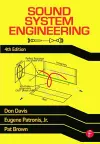
Sound System Engineering 4e
3 authors - Hardback
£135.00
Douglas Self has a worldwide reputation as a leading authority on audio amplifier design, but it is perhaps less well known that he has devoted a good deal of study to small-signal circuitry, including many years as the chief design engineer at one of the major mixing console manufacturers, where his achievements included winning a Design Council Award. His rigorous, skeptical, and thoroughly practical approach to design has been applied to the small signal area as well, and some of the results to be found in this book. Senior designer of high-end audio amplifiers and contributor to Electronics World magazine, Douglas has worked with many top audio names, including Cambridge Audio, TAG-McLaren Audio, and Soundcraft Electronics. Ben Duncan is well known to many users of audio power amplifiers around the world, both professional and domestic, through his hundreds of articles, reviews and research papers on music technology in the UK and US press, and through his part in creating several notable professional power amplifiers.Since 1977, he has been involved in the design of over 70 innovative, high-end audio products used by recording and broadcast studios, on stages, in clubs and by the most critical domestic listeners - as well as creating bespoke equipment for top musicians. Born in London, he has travelled widely but has lived mainly in Lincolnshire, home of his family for over 150 years. Outside a wide spectrum of music and festivals his interests include managing an organic garden, woodland and nature reserve; industrial archaeology, historic building restoration, psychic research, and 20th century political, social and engineering history. He is twice co-author of the book Rock Hardware in which he has chronicled the history of rock’n’roll PA. Ian Sinclair was born in 1932 in Tayport, Fife, and graduated from the University of St. Andrews in 1956. In that year, he joined the English Electric Valve Co. in Chelmsford, Essex, to work on the design of specialised cathode-ray tubes, and later on small transmitting valves and TV transmitting tubes. In 1966, he became an assistant lecturer at Hornchurch Technical College, and in 1967 joined the staff of Braintree College of F.E. as a lecturer. His first book, “Understanding Electronic Components was published in 1972, and he has been writing ever since, particularly for the novice in Electronics or Computing. The interest in computing arose after seeing a Tandy TRS80 in San Francisco in 1977, and of his 204 published books, about half have been on computing topics, starting with a guide to Microsoft Basic on the TRS80 in 1979. He left teaching in 1984 to concentrate entirely on writing, and has also gained experience in computer typesetting, particularly for mathematical texts. He has recently visited Seattle to see Microsoft at work, and to remind them that he has been using Microsoft products longer than most Microsoft employees can remember. Ian Sinclair is the author of the following Made Simple books: Lotus 1-2-3- (2.4 DOS version) MS-DOS (up to version 6.22) PagePlus for Windows 3.1 Hard drives He is also the author of many other books published under our Newnes imprint.Visit Ian's website at http://website.lineone.net/~ian_sinclair Commercial Director of Miranda Technologies, a global company specialising in television and channel-branding equipment. Worked previously as a senior designer in several of Britain’s top broadcast companies. Previously Richard worked for Pro Bel where he designed the Freeway product series. For this he was cited in Post Update magazine as “one of the twelve disciples of TV design. Richard was also responsible for the stereo enhancement system `Francinstien’ and the ‘OM’ three-dimensional stereo system. Both these systems have been used on many records, tapes and CDs as well as on television and film scores.Richard is author of Multimedia and Virtual Reality, Music Engineering and Newnes Guide to Digital Television.Director, Electric Perception Ltd John Linsley Hood (1925-2004) was head of the electronics research laboratories at British cellophane, for nearly 25 years. He worked on many instrumentation projects including width gauges and moisture meters, and made several inventions which were patented under the Cellophane name. Prior to his work at British Cellophane he worked in the electronics laboratory of the Department of Atomic Energy at Sellafield, Cumbria. He studied at Reading University after serving in the military as a radar mechanic. Linsley Hood published more than 30 technical feature articles in Wireless World magazine and its later incarnation Electronics World. He also contributed to numerous magazines including Electronics Today. Most recently Quality Assurance Manager at Accelerix in Ottawa, Canada. Currently working as an ISO 9000 Quality Assurance Manager for Conexant Systems Inc. in Ottawa, Canada.Over 25 years of experience in electronics/semiconductor device technology.Has written for Popular Electronics and the Electronics Handbook, as well asBeginning Analog Electronics Through Projects, 2E and Beginning Digital Electronics Through Projects, Modern Electronics Soldering Techniques,Dictionary of Modern Electronics Technology, and Practical Audio Amplifiercircuit Projects Don Davis and his wife, Carolyn, founded Synergetic Audio Concepts in 1972, he later retired in 1995. Don is a Senior member of the IEEE, Fellow of the AES and has received the Heyser Award, Life Time Achievement Award from NSCA and from USITT, Recognition for participation in the Brussels World Fair 1958 from the U.S. Dept. of State, and for the U.S. Exhibition in Moscow in 1959. Eugene Patronis is Professor of Physics Emeritus at the Georgia Institute of Technology in Atlanta, Georgia, USA. He has also served as an industrial and governmental consultant in the fields of acoustics and electronics. John Watkinson is an independent international consultant in advanced applications of electronics to audiovisual and avionics systems. He is a Fellow of the AES, a member of the Society of Expert Witnesses, and the British Computer Society and is a chartered information systems practitioner. He presents lectures, seminars and training courses worldwide. He is the author of many other Elsevier books, including The Art of DigitalVideo, An Introduction to Digital Video, Convergence in Broadcast and Communications Media, Television Fundamentals and The Art of the Helicopter.